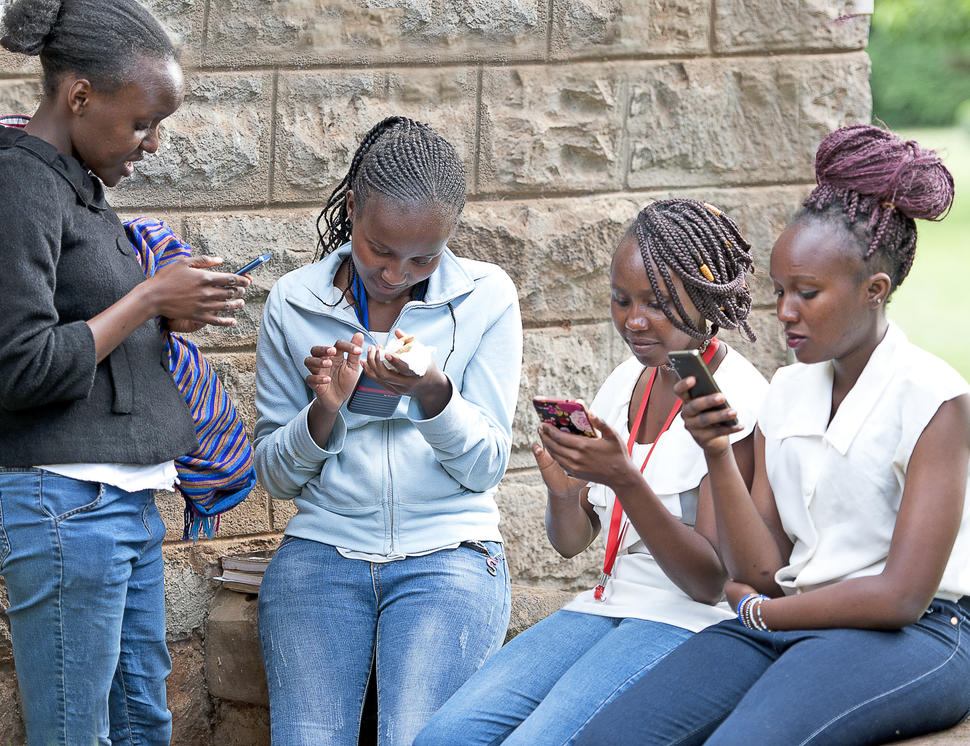More Evidence that One HPV Vaccine Dose Protects against Cancer-Causing Infections
, by Elia Ben-Ari
New results from a study in Kenya add to growing evidence that a single dose of human papillomavirus (HPV) vaccine is highly effective in protecting young women against cervical infection with cancer-causing HPV types.
Certain types of HPV cause almost all cases of cervical cancer. Vaccines that protect against these HPV types can greatly reduce the risk of developing cervical cancer, as well as other cancers caused by long-lasting HPV infections. But globally, HPV vaccination rates are low, especially in countries with high rates of cervical cancer and limited health care resources.
Giving just one HPV vaccine dose instead of the two or three doses currently recommended would reduce the cost and simplify the logistics of vaccination, which could allow more girls worldwide to be vaccinated, said Aimée Kreimer, Ph.D., of NCI’s Division of Cancer Epidemiology and Genetics.
The new findings are from the KEN SHE study, a randomized clinical trial comparing HPV infection rates in girls and young women ages 15–20 who received a single dose of HPV vaccine with rates in those who received a meningitis vaccine and 18 months later received an HPV vaccine.
The trial “is part of a global effort by researchers to make HPV vaccines more accessible to girls around the world,” said Dr. Kreimer. She leads several NCI-sponsored HPV vaccine clinical trials in Costa Rica in collaboration with Agencia Costarricense de Investigaciones Biomédicas.
In the KEN SHE trial, a single dose of either of two HPV vaccines provided 97.5% protection against new persistent infections with HPV 16 and 18, the two HPV types that cause about 70% of all cervical cancers, reported the study’s principal investigator Ruanne Barnabas, M.D., Ph.D., chief of infectious diseases at Massachusetts General Hospital, and her colleagues.
The results were published April 11 in NEJM Evidence.
Along with earlier findings from observational studies, including those from an extended follow-up of the Costa Rica HPV Vaccine Trial and recent results from a study in India, the KEN SHE results “have moved us another step closer to the important goal of increasing the accessibility of HPV vaccines,” Dr. Kreimer said. “And more data are coming from other studies that we hope will take us the rest of the way.”
Low global rates of HPV vaccination
Cervical cancer is one of the leading causes of cancer death in women in low- and middle-income countries, including in sub-Saharan Africa. Most new cases of cervical cancer worldwide—about half a million each year—occur in these countries, as do almost 90% of cervical cancer deaths.
One motivation for conducting the KEN SHE study, Dr. Barnabas said, was a visit she and the study’s co-principal investigator, Nelly Mugo, M.D., M.P.H., of the Kenya Medical Research Institute (KEMRI), made to the cervical cancer ward at a hospital in Nairobi.
“We’ve had the HPV vaccine since 2006, and we could have prevented those women from developing cervical cancer,” she said.
HPV vaccination can prevent infection with HPV types that cause most cervical cancers. Because HPV is transmitted sexually, vaccine programs generally aim to vaccinate girls and younger adolescents.
However, in 2019, only about 15% of adolescent girls worldwide had received two doses of HPV vaccine, and that rate fell to 13% during the COVID-19 pandemic, said Dr. Barnabas, who was at the University of Washington at the time the KEN SHE study was being conducted.
Many low-resource countries do not have HPV vaccination programs or the health infrastructure to offer routine cervical cancer screening. And rates of HPV vaccination in many countries that do have ready access to the vaccines, including the United States, remain less than optimal.
Looking at the protection from one HPV vaccine dose
Health officials in Kenya had planned a national HPV vaccination program for 9- to 14-year-old girls. However, due to limited supply, the vaccine has been made available only to 10-year-old girls. Although some girls up to age 14 may eventually be able to get vaccinated, HPV vaccination is not provided for those 15 and older in Kenya, Dr. Barnabas said.
“These women who are just older than 15 years have decades of life ahead of them, so we wanted to test whether a single HPV vaccine dose could reduce their risk of acquiring HPV,” she continued. Vaccination provides the most benefit if a person has not yet been infected with one or more of the high-risk HPV types targeted by the vaccines.
The KEN SHE trial, which was primarily funded by the Bill & Melinda Gates Foundation, enrolled 2,275 girls and young women ages 15–20 years at three sites in Kenya. Participants needed to be sexually active but with no more than five lifetime partners, HIV negative, and not previously vaccinated against HPV. Just over 60% of participants reported having had only one lifetime sexual partner.
Participants were randomly assigned to one of three groups:
- One group received a single dose of the bivalent HPV vaccine (Cervarix), which prevents infection with HPV 16 and 18.
- A second group received one dose of the nonavalent HPV vaccine (Gardasil 9), which protects against HPV 16, 18, and five other cancer-causing, or high-risk, HPV types.
- A third group received a vaccine that protects against meningococcal disease, a common cause of bacterial meningitis in teens and young adults.
Dr. Barnabas’s team had originally planned to give all participants in the meningococcal vaccine group one of the HPV vaccines at the end of the study, 3 years after enrollment.
However, she said, once it became clear, after 18 months of follow up, that a single dose of HPV vaccine was protective, the girls and young women in this group received an HPV vaccine.
Both HPV vaccines sharply reduced risk of infection
At enrollment, participants were tested for HPV infections of the cervix. During the study, participants received regular HPV testing and Pap tests. They also were offered sexual and reproductive health services, including family planning and testing and treatment for sexually transmitted infections including HIV.
The primary outcome of the study was vaccine efficacy—that is, the incidence of new persistent infections with an HPV type targeted by the vaccine—at 18 months. Participants who, within the first 3 months of the study, did not yet have an HPV infection with one or more of the HPV types targeted by the vaccine were included in this analysis.
Those who were infected with any of these HPV types in the first 3 months remained in the study, and all women with an abnormal Pap test are being followed until their infection clears or they receive treatment, Dr. Barnabas said.
At 18 months after enrollment, 36 of 473 women (7.6%) who received the meningococcal vaccine (control group) had a new persistent cervical HPV 16/18 infection, compared with only 2 of 985 women (0.2%) who received one of the two HPV vaccines. The efficacy of both vaccines against HPV 16/18 was 97.5%.
The KEN SHE team is continuing to follow all participants for a total of 3 years to see how long the protection against HPV infection lasts.
More data to come on single-dose vaccination
Longer-term data from the KEN SHE trial and from other randomized clinical trials involving younger girls will become available over the coming years, and will aim to answer questions about the durability of single-dose HPV vaccination and to determine how one dose compares to two doses, Dr. Kreimer said.
Current evidence that a single dose of HPV vaccine is as effective as two or three doses comes from previous studies that were not specifically designed to investigate the efficacy of one dose, but in which some participants ended up receiving only a single dose.
One trial specifically testing whether one dose is as effective as two doses is the NCI-sponsored ESCUDDO trial in Costa Rica, which Dr. Kreimer leads. Results from ESCUDDO are expected in 2025, she said.
Another important study, the DoRIS trial, is taking place in Tanzania, Dr. Kreimer said. This trial is studying the immune response to see how one, two, and three doses of the bivalent and nonavalent HPV vaccines work in young girls. The trial will indirectly assess the protection that vaccination provides by comparing the immune response in young girls in Tanzania to the immune response in participants in the KEN SHE trial, and the Costa Rica and India studies, she explained. Results are expected this year.
Meanwhile, on April 11, a World Health Organization (WHO) advisory group issued a provisional recommendation to update HPV vaccine schedules to one or two doses for most girls and young women 9–20 years old, based on results of the KEN SHE trial and other emerging evidence. A final recommendation is expected in June.
WHO has set a goal of vaccinating 90% of girls worldwide against HPV by age 15 by 2030.
In addition, in February, a United Kingdom advisory committee on vaccination issued an interim recommendation to change the HPV vaccination schedule from two doses to one in the UK’s routine vaccination program for adolescents up to age 14.
Stakeholders in KEN SHE trial shared common agenda
The KEN SHE trial was designed in close collaboration with the Kenyan Ministry of Health, KEMRI, and other study partners, Dr. Barnabas said. In addition, an outside group, the Institute for Ethics and Policy Innovation at McMaster University, conducted a formal ethics review.
All the stakeholders in the KEN SHE study “had the same agenda, with the outcome being increased access to HPV vaccination throughout the world,” she said. “That includes here in the United States, where there continue to be disparities in access to HPV vaccines and a single dose of a highly effective HPV vaccine could yield the same benefits” as were seen in Kenya.
She noted that in Australia, where a universal HPV vaccination program has sharply reduced infection with cancer-causing HPV types, “they will probably eliminate cervical cancer by 2025.
Meanwhile, we have 90% of the burden of cervical cancer in low- and middle-income countries. The disparities are really striking, and it doesn’t need to be this way.”

